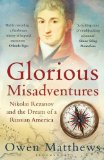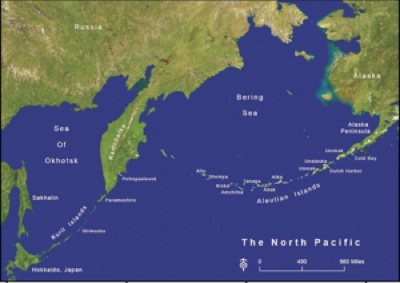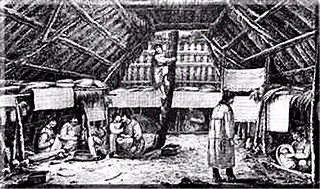Summary | Excerpt | Reviews | Beyond the Book | Read-Alikes | Genres & Themes | Author Bio

Critics' Opinion:
Readers' Opinion:
First Published:
Nov 2013, 400 pages
Paperback:
Jul 2015, 400 pages
 Book Reviewed by:
Book Reviewed by:
Kim Kovacs
Buy This Book
This article relates to Glorious Misadventures
 As Glorious Misadventures shows, the vast amount of money to be made in the Aleutian Islands and western Alaska drew many adventurers and speculators, including the primary subject of the book, Nikolai Rezanov. The Aleut Region is a string of over 70 volcanic islands stretching more than 1,000 miles across the very northern part of the Pacific Ocean and forming an arc between Alaska on the east and Russia's Kamchatka Peninsula on the West (The National Parks Service has a large, clickable map). With the exception of the Commander Islands on the far western end of the chain, the territory is considered part of the U.S. state of Alaska. It was discovered by Europeans in 1741, when a Russian expedition led by Vitus Bering stumbled across the islands while seeking shelter from a storm. They found the area inhabited by an indigenous population they referred to as the Aleuts.
As Glorious Misadventures shows, the vast amount of money to be made in the Aleutian Islands and western Alaska drew many adventurers and speculators, including the primary subject of the book, Nikolai Rezanov. The Aleut Region is a string of over 70 volcanic islands stretching more than 1,000 miles across the very northern part of the Pacific Ocean and forming an arc between Alaska on the east and Russia's Kamchatka Peninsula on the West (The National Parks Service has a large, clickable map). With the exception of the Commander Islands on the far western end of the chain, the territory is considered part of the U.S. state of Alaska. It was discovered by Europeans in 1741, when a Russian expedition led by Vitus Bering stumbled across the islands while seeking shelter from a storm. They found the area inhabited by an indigenous population they referred to as the Aleuts.
The environment is very harsh and stormy, with high winds, near constant fog and frequent rain (it is one of the rainiest places in the United States, with an average of 80 inches of rain and 250 rainy days per year). The mean temperature for the area is 38 degrees Fahrenheit, with 30F being average for January, 58F for August. The lowest temperature recorded for the area was 5F degrees, with 78F being the highest. Very little vegetation grows on the islands.
It is believed that the area's first occupants were people migrating across the Bering land bridge from Asia to the Alaskan mainland between 12,000 and 15,000 years ago. It is generally thought though, that the first Aleuts — who refer to themselves as the Unangan — arrived from Alaska to permanently settle in the area approximately 2,000 BCE.
The Unangan developed a subsistence culture centuries before the arrival of the Europeans. Their villages were generally located in coastal areas that had access to sheltered, pebbly beaches most likely so that they could safely land their boats. Houses ("barabaras") were semi-subterranean, dug into the earth and covered with sod roofs over a driftwood or bone structure. Related families shared a dwelling, which was often divided by woven mats into rooms surrounding a central common area.
 Raw meat comprised most of the Unangans' diet, with seal being their primary staple. They also hunted whale, otter and walrus, and supplemented these with fish, birds and mollusks. Food was not stockpiled for the winter, instead hunting throughout the year, although the meat was sometimes dried. Children, elderly and the infirm were fed berries, but adults generally avoided eating fruits and vegetables (leading to chronic scurvy among most members of the tribes).
Raw meat comprised most of the Unangans' diet, with seal being their primary staple. They also hunted whale, otter and walrus, and supplemented these with fish, birds and mollusks. Food was not stockpiled for the winter, instead hunting throughout the year, although the meat was sometimes dried. Children, elderly and the infirm were fed berries, but adults generally avoided eating fruits and vegetables (leading to chronic scurvy among most members of the tribes).
Young men were typically the hunters of the community, relying on baidarka – kayaks – for transportation and spears or harpoons as hunting tools. The baidarka could be designed to accommodate one or two individuals, and had excellent maneuverability over the ocean in almost all conditions. They were custom-built to match a specific hunter or hunting team, and usually took more than a year to craft. Manufactured of driftwood covered with seal and sea lion skins, they were made watertight with boiled seal oil which also made them translucent. Hunters could paddle for twelve to eighteen hours without rest, traveling 150 kilometers out to sea at speeds reaching eight miles an hour. They navigated by the stars and moon, by watching the winds and tide rips, the flight of birds and the direction of the ocean swell.
Unangan women were responsible for creating and maintaining clothing and housewares for their families. They sewed skins of seal or sea otter into a type of parka that extended below the knees. They also manufactured a reversible bird skin parka worn with the feathers in or out, depending on the weather. Men going to sea were provided with a weatherproof garment called a kamleika, which was made of seal or whale intestine. The women were also expert weavers; using only an elongated, sharpened thumbnail, grass was fashioned into baskets, sleeping mats, wall dividers, hand mitts and foot coverings. The weave – up to 2,500 stitches per square inch — was so tight that baskets could hold water. Stone, bone and ivory were also employed as household tools.
The Unangan first encountered Russian explorers in 1741, and the foreign influence radically altered their way of life. The fur trappers over-hunted the islands, decimating the animal population, which in turn caused the native populations to move or starve. The Russians also forced the most talented hunters into working for them, keeping their women and children hostage. Many of those press-ganged into trapping parties died or were killed by other native tribes trying to keep the Russians out. There were rebellions, but eventually the Unangan were completely subjugated, acting as serfs to the Russian ruling class until Russia sold the territory to the United States in 1867.
Map of Aleutian islands and picture of barabaras from National Parks Service
Filed under Places, Cultures & Identities
![]() This "beyond the book article" relates to Glorious Misadventures. It originally ran in January 2014 and has been updated for the
July 2015 paperback edition.
Go to magazine.
This "beyond the book article" relates to Glorious Misadventures. It originally ran in January 2014 and has been updated for the
July 2015 paperback edition.
Go to magazine.





The Flower Sisters
by Michelle Collins Anderson
From the new Fannie Flagg of the Ozarks, a richly-woven story of family, forgiveness, and reinvention.

The House on Biscayne Bay
by Chanel Cleeton
As death stalks a gothic mansion in Miami, the lives of two women intertwine as the past and present collide.

The Funeral Cryer by Wenyan Lu
Debut novelist Wenyan Lu brings us this witty yet profound story about one woman's midlife reawakening in contemporary rural China.
Your guide toexceptional books
BookBrowse seeks out and recommends the best in contemporary fiction and nonfiction—books that not only engage and entertain but also deepen our understanding of ourselves and the world around us.